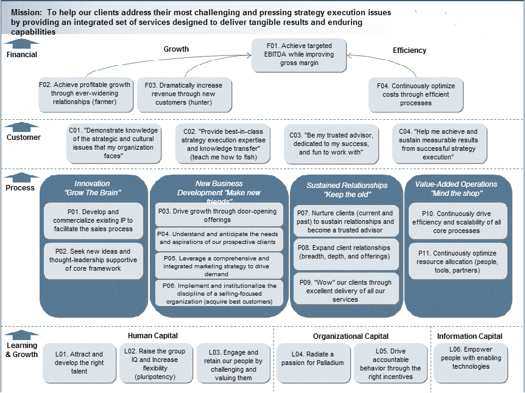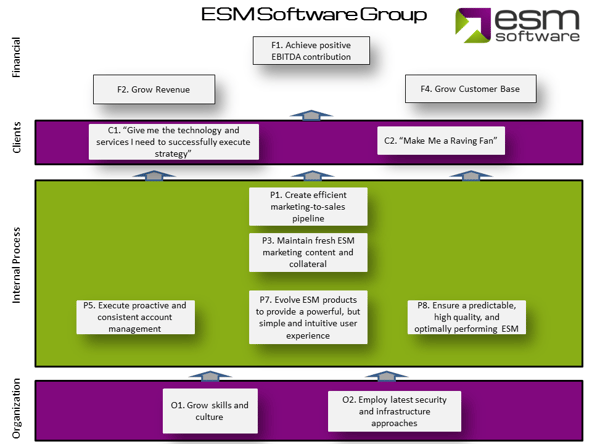If you’ve ever been an avid gym member, you’ve probably dreaded the first couple weeks of every new year.
New Year’s resolutions can bump gym attendance by as much as 50% in the first couple weeks of a new year. Of course, that newfound discipline is short lived. By the second week of February, as much as 80% of the new members likely have already dropped out.
Starting a routine is hard, even if you know it’s in your best interest. This is especially true for organizations — more so when the return on investment is long-term.
This is the scenario organizations often face when working on their strategic planning process. It’s easy to have a grand vision of a disciplined strategic management process. It is much harder to turn that plan into a reality.
I’m guilty of it too. Even as a Balanced Scorecard consultant, I struggle to hold regular strategy review meetings in my own company.
Balanced Scorecard Failure #1 - Trying to fit every detail into our Balanced Scorecard
Up until recently, our company, ESM, has had about 25 objectives on our organizational strategy map, with an additional 50 measures and initiatives. That’s about par for the course across industries, and we felt that it was a manageable number. However, we’re a small team, and the process of even just defining each objective, measure, and initiative is labor-intensive, let alone regularly updating each element. Managing our complex strategy map felt like extra work on top of everything else that needed to get done yesterday.
Our old map looked like this:

I have to say, it’s a great strategy map. It follows all of the best practices with causal linkages, themes, and a clearly articulated mission statement.
Yet if I were to ask you to look at that map and tell me what our five priorities were for that year, could you?
I couldn’t.
Balanced Scorecard Failure #2 - Not Keeping it simple
Our old strategy map included many ways of breaking down our performance but failed to focus the team on clearly articulated priorities. That isn’t an unusual challenge for our clients. Complex strategy maps are a symptom of departmental desire to be represented as part of the strategy. While it is true that operations are critical to the success of the business, they may not necessarily be one of the top strategic change objectives.
Remember: Operations preserve value. Strategy creates new value.
The different departments and teams competing for limited real estate on your strategy map is a good metaphor for the fundamental challenge of strategy: you need to make tough decisions on how to use your limited resources. We wanted our strategy map to reflect that.
So we slimmed it down.
Our new strategy map focuses on just 12 objectives, cutting our old map in half. Instead of cluttering our strategy with operational objectives (that we have separate weekly meetings to discuss anyway), we focused on the major priorities for the year. Here is what our new map looks like:
With fewer objectives, it became much easier to communicate our strategy to the team. In fact, I can do it in four short bullets:
- Improve on a high quality product that makes the BSC simple to manage
- Market how valuable our product is
- Teach our clients how to better manage their BSC with engaging and proactive account management
- Weekly ice cream socials
Want to see it? Schedule a demo now.
Reducing the number of objectives had an immediate impact on our ability to prepare for and conduct strategy review meetings. In the year since we implemented our new map, we have been much more disciplined conducting quarterly strategy reviews and refreshes.
Slimming down has also changed how the team perceives strategy reviews. With only 12 objectives, suddenly, the team stopped dreading strategic planning, and became more engaged with the process itself.
So to recap, here are two things to think about as part of your strategic planning and strategy review meeting preparation:
1) Less is more
There is no perfect number of objectives for your organization. Especially in larger organizations, it is common to have over 20 objectives on your map. But in general, a good number to shoot for is 12. If you tell your team that you need to summarize the direction of your organization in just 12 objectives, you will spark some powerful conversations around what those 12 objectives should be. You might not get that concise, but it is a good target to work towards.
The “less is more” philosophy applies to your initiatives and measures as well. If you have 12 objectives and an overwhelming amount of measures and initiatives, you’ll defeat the purpose of having a focused strategy map. Pick the critical measures and stick with them.
2) Schedule your strategy review meetings now
Pick your strategy review dates and stick with them. We recommend quarterly meetings, but find the frequency that works for you. By scheduling your meetings in advance, you ease logistical concerns down the road, and plant a clear stake in the ground indicating your commitment to this strategy management process.









